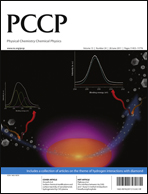Hydrogen plasma interaction with (100) diamond surfaces
Abstract
Polycrystalline diamond films exhibiting (100) oriented surfaces have been subject to a low pressure hydrogen plasma for durations up to 20 h. The topography of spatially defined 20 × 20 μm areas of the samples were imaged by

- This article is part of the themed collection: Hydrogen Interactions with Diamond

 Please wait while we load your content...
Please wait while we load your content...